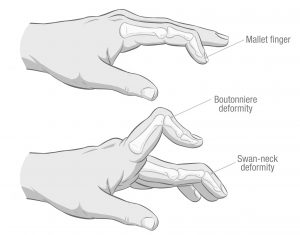Dislocation of the proximal interphalangeal joint (closest joint of the finger) is also very common. Dorsal (to the back) dislocation may lead to volar plate and ligament damage, and therefore requires proper diagnosis and follow up. If the dislocation is stable, only buddy taping (where the 2 fingers are taped together) is required, followed by early mobilization to avoid stiffening of the joint. If unstable, the finger should be braced in 30 deg. of flexion and slowly extended over 3 to 4 weeks. Volar dislocations (to the front) are less common, but usually involve ligament damage and disruption of the portion of the finger extensor tendon that crosses the joint. This leads to development of the boutonniere deformity, where the proximal interphalangeal joint is flexed, and the distal interphalangeal joint is extended.
These injuries often require surgery or splint with the joint locked out into full extension for 6 weeks, whilst maintaining range of movement at the distal interphalangeal joint (the furthermost most joint of the finger). The opposite deformity to a boutonniere deformity is a swan neck deformity, which may also occur after a volar plate disruption where the proximal interphalangeal joint is hyperextended, and the distal interphalangeal joint flexed. Many athletes will delay surgery for this condition until the end of a season, or until retirement, as after a period of 8 weeks splinting, pain is not an issue. If the athlete can cope with occasional locking, the condition may be managed conservatively.
The distal interphalangeal joint may also be dislocated, usually to the back. This occurs due to forced hyperextension. This dislocation may be reduced with traction and flexion. After relocation, the finger should be placed in 10 deg. of flexion for 3 weeks. Dislocation of this joint towards the front is far less common, and usually occurs with fracture. This injury will result in a mallet finger appearance, where the distal interphalangeal joint is flexed. Thus, all dislocations to the front, and all injuries resulting in a mallet finger deformity require imaging.
